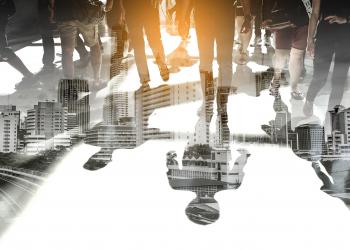Co-Creating Neighbourhoods for Encounter and Belonging
“There is no better question than that of how we live together in mixed neighborhoods.’' With these words, Member of the European Parliament (EP) Dr. Pierrette Herzberger-Fofana, Co-President of the EP’s Anti-Racism and Diversity Intergroup (ARDI) opened the event Co-Creating Neighbourhoods for Encounter and Belonging. More than 110 participants from across Europe came together for a dynamic exchange on how urban design in highly diverse neighbourhoods can contribute to social change at the local level. The online event was co-hosted by ARDI, the Alliance 4 Europe and the Baha’i International Community (BIC) Brussels office on 15 June 2021. At the heart of the conversation stood the question of “how to build volition in populations from diverse backgrounds to not just live side by side, but to get to know each other, and jointly contribute towards the transformation of [their] neighbourhood,” drawing on the “wide range of experiences and talents diversity brings,” as introduced by Ms Rachel Bayani, representative of the BIC Brussels. .
Lord Mayor of Dublin Hazel Chu, drawing on her own family’s experience of migration to Ireland, emphasised that fostering a culture of mutual support among diverse neighbours can give rise to a sense of community, whereby the process of learning to work together in a neighbourhood begins with “being able to turn to your neighbour” for help. “That’s how we build a community,” she said at the event. Juliette Jestin from the Organisation for Economic Cooperation and Development (OECD), who coordinates its Champion Mayors for Inclusive Growth initiative, addressed the role of urban design in encouraging diverse people to come together through the creation of inclusive public spaces in a neighbourhood. She shared that the global network of mayors has been reflecting on its cumulative experience engaging local populations in the design of public spaces as a means to understand their needs and build on their lived experiences.
Building on these elements, Liam Stephens, research associate at the Free University of Amsterdam, noted that beautifully designed spaces alone tend to be insufficient for people to overcome hesitancy to interact with one another and to cultivate a sense of belonging. He highlighted the need for a conversation that “extends beyond just the physical space” and that purposefully explores “the kind of community we want to see,” drawing on the power of imagination and the participation of a growing number and diversity of people. His comments reflected the contribution of panelist Rozina Spinnoy, founder and director of Business Improving District Belgium, who emphasized that the first question we need to ask is: what does community mean? She added that “It is indeed about us co-designing that story of what it means to create a sustainable, inclusive neighborhood.”
Several participants highlighted how volition to work for the betterment of one’s community is also built through conversations that raise collective awareness about the reality of one’s neighbourhood. Kehler Moghen from Norway shared that in her own neighbourhood, a lot of thought was given to “what is common to us as human beings.” She added that the continuity of constructive conversations among neighbours is what makes the difference, “We need to come together to have conversations at a much deeper level on a regular basis, not just once in a year or twice in a year, but continuously”.
Biser Alekov, a Brussels-based activist, described efforts to identify and draw on the capacities and talents of people living together in a shared geographical space through the experience of a “Mother Centre”. Created together with mothers of diverse migrant backgrounds, a “Mother Centre” is built around the conviction that all of the women in the neighborhood have “talent and expertise”, and that spaces need to be created to allow women “to implement [their] talent there.”
What appears to be needed, then, are physical spaces that “are accessible and welcoming to everyone” as well as social spaces imbued with “common causes around which people [can] gather,” stressed Ms. Talia Melic, PhD researcher in urban geography at the Universities of Melbourne and Paris-Est. She added, “ultimately togetherness in diversity is not an end in itself,” but rather “a means to work for the transformation of the community, that reflects the capacities and richness that different individuals bring.”
Watch glimpses of the event here.
